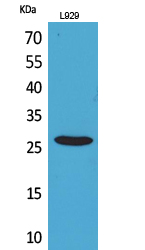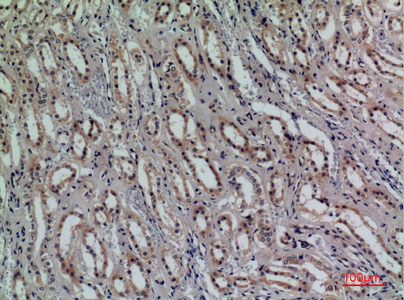CD159a/c Polyclonal Antibody
- Catalog No.:YT5288
- Applications:WB;IHC;IF;ELISA
- Reactivity:Human;Rat;Mouse;
- Target:
- CD159a/c
- Fields:
- >>Antigen processing and presentation;>>Natural killer cell mediated cytotoxicity;>>Graft-versus-host disease
- Gene Name:
- KLRC1/KLRC2/KLRC3
- Protein Name:
- NKG2-A/NKG2-B type II integral membrane protein/NKG2-C type II integral membrane protein/NKG2-E type II integral membrane protein
- Human Gene Id:
- 3821
- Human Swiss Prot No:
- P26715
- Immunogen:
- The antiserum was produced against synthesized peptide derived from the Internal region of human KLRC1/2/3. AA range:101-150
- Specificity:
- CD159a/c Polyclonal Antibody detects endogenous levels of CD159a/c protein.
- Formulation:
- Liquid in PBS containing 50% glycerol, 0.5% BSA and 0.02% sodium azide.
- Source:
- Polyclonal, Rabbit,IgG
- Dilution:
- WB 1:500 - 1:2000. IHC: 1:100-300 ELISA: 1:20000.. IF 1:50-200
- Purification:
- The antibody was affinity-purified from rabbit antiserum by affinity-chromatography using epitope-specific immunogen.
- Concentration:
- 1 mg/ml
- Storage Stability:
- -15°C to -25°C/1 year(Do not lower than -25°C)
- Other Name:
- KLRC1;NKG2A;NKG2-A/NKG2-B type II integral membrane protein;CD159 antigen-like family member A;NK cell receptor A;NKG2-A/B-activating NK receptor;CD159a;KLRC2;NKG2C;NKG2-C type II integral membrane protein;CD159 antigen-like family member C;NK cell receptor C;NKG2-C-activating NK receptor;CD159c;KLRC3;NKG2E;NKG2-E type II integral membrane protein;NK cell receptor E;NKG2-E-activating NK receptor
- Observed Band(KD):
- 25kD
- Background:
- Natural killer (NK) cells are lymphocytes that can mediate lysis of certain tumor cells and virus-infected cells without previous activation. They can also regulate specific humoral and cell-mediated immunity. The protein encoded by this gene belongs to the killer cell lectin-like receptor family, also called NKG2 family, which is a group of transmembrane proteins preferentially expressed in NK cells. This family of proteins is characterized by the type II membrane orientation and the presence of a C-type lectin domain. This protein forms a complex with another family member, KLRD1/CD94, and has been implicated in the recognition of the MHC class I HLA-E molecules in NK cells. The genes of NKG2 family members form a killer cell lectin-like receptor gene cluster on chromosome 12. Multiple alternatively spliced transcript variants encoding distinct isoforms have been observed. [provide
- Function:
- function:Plays a role as a receptor for the recognition of MHC class I HLA-E molecules by NK cells and some cytotoxic T-cells.,online information:NKG-2A,similarity:Contains 1 C-type lectin domain.,subunit:Can form disulfide-bonded heterodimer with CD94.,tissue specificity:Natural killer cells.,
- Subcellular Location:
- Cell membrane ; Single-pass type II membrane protein .
- Expression:
- Predominantly expressed in NK cells (at protein level) (PubMed:9430220, PubMed:9485206, PubMed:20952657). Expressed in intraepithelial CD8-positive T cell subsets with higher frequency in gamma-delta T cells than alpha-beta T cells (at protein level) (PubMed:18064301). Expressed in memory gamma-delta T cells (at protein level) (PubMed:20952657). Restricted to a subset of memory/effector CD8-positive alpha-beta T cells (at protein level) (PubMed:12387742). Expressed in intratumoral NK and CD8-positive T cells (PubMed:30503213). Expressed in melanoma-specific cytotoxic T cell clones (at protein level) (PubMed:9485206). KLRD1-KLRC1 and KLRD1-KLRC2 are differentially expressed in NK and T cell populations, with only minor subsets expressing both receptor complexes (at protein level) (PubMed:20
- June 19-2018
- WESTERN IMMUNOBLOTTING PROTOCOL
- June 19-2018
- IMMUNOHISTOCHEMISTRY-PARAFFIN PROTOCOL
- June 19-2018
- IMMUNOFLUORESCENCE PROTOCOL
- September 08-2020
- FLOW-CYTOMEYRT-PROTOCOL
- May 20-2022
- Cell-Based ELISA│解您多样本WB检测之困扰
- July 13-2018
- CELL-BASED-ELISA-PROTOCOL-FOR-ACETYL-PROTEIN
- July 13-2018
- CELL-BASED-ELISA-PROTOCOL-FOR-PHOSPHO-PROTEIN
- July 13-2018
- Antibody-FAQs
- Products Images

- Western Blot analysis of L929 cells using CD159a/c Polyclonal Antibody. Secondary antibody(catalog#:RS0002) was diluted at 1:20000

- Immunohistochemical analysis of paraffin-embedded human-kidney, antibody was diluted at 1:100

- Western blot analysis of lysate from L929 cells, using KLRC1/2/3 Antibody.



